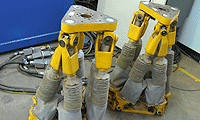


3rd Porto Meeting on
MATHEMATICS for INDUSTRY 28th to 30th April 2011
MATHEMATICS for INDUSTRY 28th to 30th April 2011
| home |
| about the meeting |
| main speakers/courses |
| talks/posters |
| registration form |
| study group |
| organizers |
| travel & accomodations |
| participants |
| poster |
| timetable |
| contacts |
| documentation |
| impac |
Posters
- Sandra
Aires, Instituto
Politécnico do Porto (ISEP/LEMA), sma@isep.ipp.pt) and F. D.
d'Almeida,
(FEUP/CMUP )
Title: O problema de
valores próprios quadrático aplicado ao estudo da estabilidade dinâmica
de um sistema com atrito.
Abstract: O
problema de valores próprios quadrático tem muitas aplicações em
ciências e engenharia, tais como, em mecânica estrutural, teoria de
controlo, dinâmica de fluidos, etc.. O problema de valores próprios
quadrático consiste na determinação de valores e vectores próprios de
uma equação quadrática cujos coeficientes, neste caso, são matrizes
reais ou complexas de dimensão n. Estamos especialmente interessados no
caso em que a matriz do termo quadrático é uma matriz de massa,
simétrica e definida positiva, a matriz do termo linear é uma matriz de
atrito, que inclui não só os efeitos de atrito do material, mas também
os efeitos de atrito induzidos pela fricção, e o termo independente é
uma matriz de rigidez que aqui pode ser ou não simétrica devido à
fricção. Este problema surge em mecânica estrutural para o estudo da
estabilidade dos sistemas de travagem. A solução usual para este tipo
de problemas é a linearização, ou seja, uma transformação do problema
quadrático para a forma linear de dimensão 2n. A dimensão dos problemas
a tratar é da ordem de centenas de milhar. Neste poster vamos
apresentar resultados obtidos com um problema teste de menor dimensão,
mostrando a evolução do espectro à medida que a parte não simétrica do
problema aumenta.
Title: Dengue disease:
modelling and vaccination
Abstract: Dengue is a vector-borne
disease that affects specially tropical and subtropical areas. It is
proposed an epidemiological model with host and vector compartments.
Some simulations were done, using vector control tools and an hypothetical vaccine as an extra protection of the population.
Some simulations were done, using vector control tools and an hypothetical vaccine as an extra protection of the population.
Title: Changing the
geometry of agent formations in Minimal time: collision avoidance and
variable agent velocities
Abstract: We address the problem of
dynamically switching the topology of a formation of a number of
undistinguishable agents. The need to switch formation topology arises
in situations when mission requirements change or there are obstacles
or boundaries along the formation path that are inadequate for the
current topology. Here we propose a strategy to determine which agent
should go to each of the new target positions, avoiding collisions
among agents and assuming no agent communication. In addition, each
agent can also chose its travelling speed from among a set of
pre-defined velocities, which is a main distinguishing feature from
previous work. Among all possible solutions we seek one that minimizes
the total formation switching time, i.e., that minimizes the maximum
time required by all agents to reach their positions in the new
formation topology. We describe an algorithm based on dynamic recursion
to solve this problem and provide some examples.